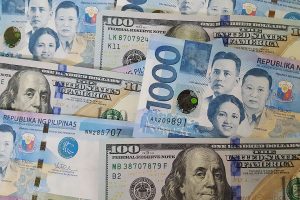THE PESO may remain weak against the dollar as the Bangko Sentral ng Pilipinas (BSP) is not expected to “strongly” defend the currency amid its recent dovish policy signals, Bank of America (BofA) Global Research said.
“(The Philippine peso) remains on the weaker side, taking cues from the BSP’s dovish turn in the last policy meeting and lack of concern on the FX (foreign exchange) moves,” it said in a report.
BofA Global Research said the “bearish positioning could slow further weakness” but the BSP appears less likely to defend the peso from falling to P59 against the US dollar.
“Geopolitical concerns need to be watched as another trigger for further weakness,” it added.
The peso closed at P58.86 against the dollar on Wednesday, weakening by nine centavos from its P58.77 finish on Tuesday. This was its weakest finish in over 20 months or since its P58.87-per-dollar close on Oct. 24, 2022.
The BSP earlier said that the peso’s recent performance is “temporary” given the expected delay in the US Federal Reserve’s policy easing.
BSP Governor Eli M. Remolona, Jr. had also said that it is a case of a “strong dollar” and not a weak peso due to the tensions in the Middle East.
To keep markets orderly and control speculation, the BSP said that it has intervened in the foreign exchange market in “modest” amounts.
“(Philippine peso’s) weakness may reflect concerns on a weak growth outlook which has also led to a dovish turn in BSP’s policy guidance,” BofA said.
“The governor’s comments about the possibility of a cut in the August meeting may have changed market expectations on the policy priorities between supporting the domestic economy vs. preserving FX stability,” it added.
Mr. Remolona earlier signaled the possibility of starting the easing cycle by August, for a total of 25-50 bps worth of cuts for the entire year.
“Lower rates in the Philippines have raised the chances of even narrower interest-rate buffer against (US dollar) rates, which may impact the hedging behavior of corporates,” BofA said, adding pressure could go up if the US dollar strength picks up or US yields rise again.
Meanwhile, BofA said that elevated inflation remains the top risk facing the Philippines.
“Food price shock and higher commodity prices in general remain the key risk for the Philippines, leading to a widening of the twin deficits,” it said.
Inflation could possibly breach the 2-4% target band until July, according to the central bank. The BSP expects inflation to average 3.5% for the full-year 2024.
“Geopolitical risks due to border clashes with China could impact investment flows,” BofA added. — Luisa Maria Jacinta C. Jocson
